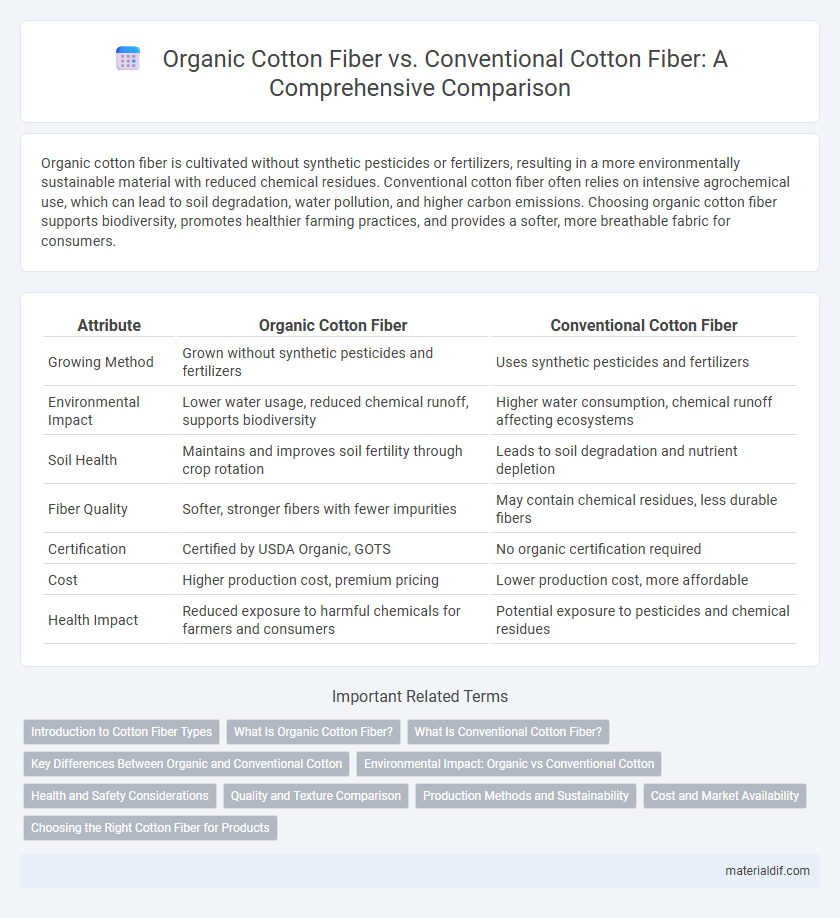Organic cotton fiber is cultivated without synthetic pesticides or fertilizers, resulting in a more environmentally sustainable material with reduced chemical residues. Conventional cotton fiber often relies on intensive agrochemical use, which can lead to soil degradation, water pollution, and higher carbon emissions. Choosing organic cotton fiber supports biodiversity, promotes healthier farming practices, and provides a softer, more breathable fabric for consumers.
Table of Comparison
| Attribute | Organic Cotton Fiber | Conventional Cotton Fiber |
|---|---|---|
| Growing Method | Grown without synthetic pesticides and fertilizers | Uses synthetic pesticides and fertilizers |
| Environmental Impact | Lower water usage, reduced chemical runoff, supports biodiversity | Higher water consumption, chemical runoff affecting ecosystems |
| Soil Health | Maintains and improves soil fertility through crop rotation | Leads to soil degradation and nutrient depletion |
| Fiber Quality | Softer, stronger fibers with fewer impurities | May contain chemical residues, less durable fibers |
| Certification | Certified by USDA Organic, GOTS | No organic certification required |
| Cost | Higher production cost, premium pricing | Lower production cost, more affordable |
| Health Impact | Reduced exposure to harmful chemicals for farmers and consumers | Potential exposure to pesticides and chemical residues |
Introduction to Cotton Fiber Types
Organic cotton fiber is cultivated without synthetic pesticides or fertilizers, promoting sustainable farming practices and reducing environmental impact, while conventional cotton fiber relies heavily on chemical inputs to enhance yield. The difference in cultivation methods affects fiber quality, with organic cotton often being softer and more breathable compared to conventionally grown cotton. Choosing organic cotton fiber supports eco-friendly production and healthier soil ecosystems, making it a preferred option in sustainable textile manufacturing.
What Is Organic Cotton Fiber?
Organic cotton fiber is grown without synthetic pesticides, herbicides, or genetically modified organisms, relying on natural processes and crop rotations to maintain soil health. It supports biodiversity and reduces environmental impact by avoiding harmful chemicals commonly used in conventional cotton farming. Organic cotton fibers offer a sustainable alternative that promotes eco-friendly textile production while maintaining comparable softness and durability.
What Is Conventional Cotton Fiber?
Conventional cotton fiber is produced using synthetic pesticides, herbicides, and fertilizers that enhance crop yield but may contribute to soil degradation and environmental pollution. This type of cotton is typically genetically modified to resist pests and tolerate herbicides, supporting large-scale industrial farming practices. Conventional cotton fibers tend to have a higher environmental footprint compared to organic cotton due to intensive water usage and chemical treatments.
Key Differences Between Organic and Conventional Cotton
Organic cotton fiber is grown without synthetic pesticides or fertilizers, reducing environmental pollution and promoting soil health, whereas conventional cotton relies heavily on chemical inputs that can harm ecosystems. Organic cotton typically uses rainwater for irrigation, resulting in lower water consumption compared to the high irrigation demands of conventional cotton farming. Moreover, organic cotton fibers often have longer staples, contributing to enhanced durability and softness in finished textiles compared to conventional cotton fibers.
Environmental Impact: Organic vs Conventional Cotton
Organic cotton fiber cultivation reduces pesticide and synthetic fertilizer usage by approximately 90%, leading to significantly lower soil and water contamination compared to conventional cotton. Conventional cotton farming consumes 16% of global insecticides and 6.8% of herbicides, exacerbating biodiversity loss and chemical runoff. Water consumption in organic cotton production is often 91% less than conventional methods, contributing to improved water conservation and reduced environmental strain.
Health and Safety Considerations
Organic cotton fiber is cultivated without synthetic pesticides, reducing exposure to harmful chemicals for farmers and consumers, thus promoting better health and safety. Conventional cotton fiber often involves the use of chemical fertilizers and pesticides, which can cause skin irritations, respiratory problems, and long-term environmental contamination. Choosing organic cotton fiber minimizes toxic residues in textiles, enhancing safety for sensitive skin and reducing ecological risks.
Quality and Texture Comparison
Organic cotton fiber exhibits superior quality and texture compared to conventional cotton fiber due to its natural growth process free from synthetic pesticides and fertilizers, resulting in stronger and softer fibers. The lack of chemical residues preserves fiber integrity, enhancing breathability and hypoallergenic properties while maintaining durability. Textile manufacturers favor organic cotton for premium products that offer a smoother hand feel and enhanced comfort over standard conventional cotton fibers.
Production Methods and Sustainability
Organic cotton fiber is produced without synthetic pesticides or fertilizers, utilizing natural farming methods that promote soil health and biodiversity. Conventional cotton fiber relies heavily on chemical inputs, which can lead to soil degradation and water pollution. Organic cotton's sustainable production significantly reduces environmental impact, offering a more eco-friendly alternative to traditional cotton farming.
Cost and Market Availability
Organic cotton fiber typically commands a higher price due to sustainable farming practices and lower yields compared to conventional cotton fiber, which benefits from economies of scale and widespread industrial cultivation. The market availability of organic cotton fiber is more limited, presenting challenges for mass production and consistent supply chains, whereas conventional cotton fiber dominates global markets due to its extensive cultivation and established industrial infrastructure. These factors influence brand sourcing decisions, with organic cotton often preferred for premium, eco-friendly products despite its cost and availability constraints.
Choosing the Right Cotton Fiber for Products
Organic cotton fiber is cultivated without synthetic pesticides, promoting sustainable agriculture and reducing environmental impact, making it ideal for eco-conscious products. Conventional cotton fiber often yields higher quantities at lower costs due to chemical-intensive farming but carries risks of soil degradation and pesticide residue. Selecting the right cotton fiber depends on balancing product sustainability priorities, cost constraints, and desired fabric quality to meet consumer expectations effectively.
Organic Cotton Fiber vs Conventional Cotton Fiber Infographic

 materialdif.com
materialdif.com